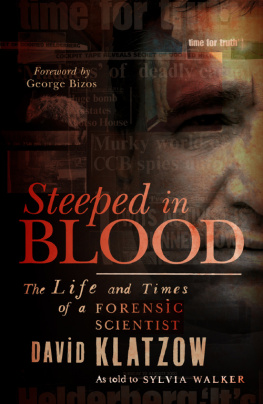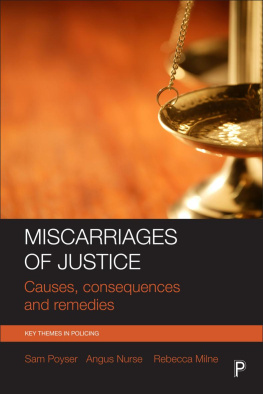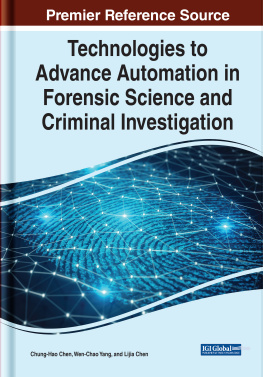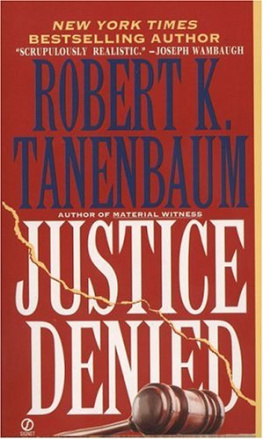


Published by Zebra Press
an imprint of Random House Struik (Pty) Ltd
Company Reg. No. 1966/003153/07
Estuaries No. 4, Oxbow Crescent, Century Avenue,
Century City, Cape Town, 7441
PO Box 1144, Cape Town, 8000, South Africa
www.zebrapress.co.za
First published 2014
Publication Zebra Press 2014
Text David Klatzow
Cover photos: Dead body iStockphoto/MorelSO;
Police line iStockphoto/lightkey
All other images on cover and inside (unless otherwise stated) David Klatzow
All rights reserved. No part of this publication may be reproduced, stored in a retrieval system or transmitted, in any form or by any means, electronic, mechanical, photocopying, recording or otherwise, without the prior written permission of the copyright owners.
PUBLISHER: Marlene Fryer
MANAGING EDITOR: Ronel Richter-Herbert
EDITOR: Beth Lindop
PROOFREADER: Bronwen Leak
COVER DESIGN: Michiel Botha
TEXT DESIGN: Jacques Kaiser
TYPESETTER: Martin Endemann/Monique van den Berg
ISBN 978 1 77022 694 4 (print)
ISBN 978 1 77022 695 1 (ePub)
ISBN 978 1 77022 696 8 (PDF)
CONTENTS
ACKNOWLEDGEMENTS
The modest success of my previous book about my thirty years in forensic science emboldened me to write in this book about some of the problems I have encountered along the way. Like all narratives, the formative influences in my life paved the way for my subsequent career in forensic science.
One can never overstate the value of empathetic teachers who awakened dormant interests in the budding student. One of the first was a teacher at St Martins School in Rosettenville. His name was Edwin Ainscow and he beat the notion of the balanced chemical equation into my head. Subsequently, a teacher called Rob Taylor aroused my interest in organic chemistry, and biochemistry in particular. In Steeped in Blood I mentioned my English teachers at Nigel English Medium High School: Jean Cameron and Dr Gevers. English teachers have the most amazing opportunity to mould the young mind in so many ways, and these two were exceptional in the breadth and depth of their understanding, and in their willingness to impart such learning.
Having left high school, I came under the influence of many men at university, some good and some indifferent. I mentioned in the introduction to Steeped in Blood my immense debt to Professor Jack Allan, who guided me in anatomical pathways. An oversight in the previous book was my omission of Professor Charles Isaacson, who took it upon himself to teach me the rudiments of pathology. They were enjoyable lessons of enormous value to me in the years to come and he, I am sure, is unaware of how much of a debt of gratitude I owe him. He has remained a steadfast friend, humble, erudite and caring.
My friend Solly (Stephan) van Nieuwenhuizen, now a silk at the Johannesburg Bar, has been a constant friend in need. He has, over the nearly thirty years of our friendship, been a consistent if sometimes irascible teacher of the law to me. His friendship has been invaluable.
My interest in serology was encouraged in the early stages of my PhD by husband-and-wife team Gerard and Dell Vos. He was a serologist of international repute who worked for, and was unappreciated by, the Natal Blood Transfusion Service, run at the time by Peter Brain. Gerard was quick to appreciate the role of the cell surface in cancer research, something that made of him a rather rare bird in South Africa in the 1970s. His encouragement and help was invaluable in my early career, especially his support of an intellectual nature.
During my time as a postgraduate student in the Department of Surgery, I was encouraged and supported by a number of senior members of staff. Professor Don Heynes, who was head of the ear nose and throat division, was always available and encouraging. He included me each week in his ward rounds and gave me valuable insights into the clinical aspects of the cancer research that I was engaged in. The same was true of Professor Noll van Blerk, head of the urology department. Professor D.J. du Plessis, who was head of surgery, was a strict but fair disciplinarian who would open doors to assist students he thought worth helping. God help you if you crossed him; his wrath was all-powerful and far reaching. I found him helpful, supportive and encouraging. He called me into his office at 6:30 one morning and gave me a lecture on how privileged I was to be given the opportunity to lay one brink in the edifice of knowledge. He ended by saying to me, Dont try to build the entire building.
This section would be incomplete without mentioning the able assistance that I have received from my assistant, Natalie Salter-Buffard. At all times, her high standards and professionalism has made every bit of difference. Her sometimes Cerberus-like treatment of some of the strange clients who call on me has been both helpful and entertaining. Her untiring help with the preparation of this book has been invaluable. Thanks, Natalie.
To the staff of Zebra Press, especially Marlene Fryer, who has kept up the pressure, and Beth Lindop, who has tied up all the loose ends, thanks for your patience and persistence.
INTRODUCTION
The concept of justice goes far back into the dawn of recorded time. The ancient Egyptian tombs show ample evidence of weighing the soul of the dead, an idea illustrated in the Book of the Dead, an ancient Egyptian funerary text designed to assist souls through the underworld to the afterlife. In modern times, the concept of justice is represented by the Roman goddess Justitia, or Lady Justice. She is usually portrayed as a blindfolded woman with a sword in one hand and scales in the other. The symbolism is unequivocal and simple: justice should be blind; your class, colour, wealth and rank should play no part. The scales tell us that evidence must be weighed, the issues viewed in a balanced way. (Lawyers speak of something being proved on the balance of probabilities.) The whiteness and simplicity of her toga-like gown speaks to the need for justice to encompass not only a civilised legal component but also a greater moral purpose.
Our judges are steeped in this tradition. They are referred to as the honourable Mr Justice So-and-so. They wear robes that set them apart from the masses, and in the High Courts are addressed as My Lord or My Lady. The courts resound with obsequious phrases, such as If your Lordship pleases and May it please the Court, your Ladyship. Invariably the judicial bench is physically elevated well above the rest of the court.
The purpose of a court is to see to it that some form of justice is meted out to those unfortunate enough to end up in front of the judge presiding. Increasingly it is accepted that the law should be tempered with equity to better ensure that justice is served.
Does this happen in practice? I would venture to say not often. The legal process is a very expensive one; often justice is not achieved because the parties are not able to afford the costs. Costs of advocates and their instructing attorneys mount up alarmingly. If a senior counsel, together with junior counsel, is employed, the costs rapidly become stratospheric. This situation is made worse by the fact that the loser in most court actions is burdened still further with a costs order for the winning sides expenses in addition to his own. Should a party be acquitted in a criminal case, no costs order is awarded against the state, as would occur in a civil matter. As several of the cases discussed in this book reveal, the accused also often lacks the necessary finance to employ adequate technical forensic expertise to challenge the vast resources of the state.
Next page







